October 31, 2004
US politics
I'm going bush for a day or so.
I will be unable to connect to the internet until Tuesday.
October 30, 2004
global warming?
Is there an accelerating melting and iceberg release in Greenland and the Arctic?

Andrew C. Revkin/The New York Times
More specifically is the miles-high pile of ice cloaking Greenland in balance or not? Are its edges losing more to icebergs and melting than its summit gains each year in snow?

Andrew C. Revkin/The New York Times
Some background
Andrew Rifkin writes:
"Around the edges, Greenland's great mass of ancient ice, which has piled up nearly two miles high across the world's largest island over 120,000 years, is both melting and sliding into the sea at a disturbingly accelerating rate. Already in some places, the coastal erosion of the great ice sheet has been fast enough to cause interior ice fields to measurably slump.The changes are forcing theorists who had once seen the island's ice as relatively stable to rethink their projections for how the ongoing global warming trend, driven partly by human actions, could affect sea levels in coming decades and centuries."
More here.
I had understood that the Antarctic icecap was also melting but this report suggests otherwise.
October 29, 2004
anywhere
I'm too tired to write.
I kept on thinking about becoming nomadic and going on the road in a postmodern way. We postmoderns do not like borders but we sure do like 'the borderlands'!
October 28, 2004
more Tracey Emin

Tracey Emin, I think about sex most of the time, 2003, black ink on paper, from Fear, War and The Scream 2004
a theoretical moment
A post on culture based on this review
Francis Mulhern's central argument in his book Culture/Metaculture is that, although the tradition which he calls ‘Kulturkritik’ (of which more in a moment) and the movement or discipline now called ‘Cultural Studies’ may appear to be almost diametrically opposed in their aims and political affiliations, they in fact exhibit a fundamental continuity at the level of form. The form is that both are metadiscourses.
Mulheren argues that ‘Kulturkritik’ and ‘Cultural Studies’ each appeal to a (very different) notion of ‘culture’ to ‘mediate a symbolic metapolitical resolution of the contradictions of capitalist modernity’. ‘Kulturkritik’ attempts to ‘spiritualize’ the notion as ‘the higher truth of humanity or the nation’, or as some transcendent locus of value. Cultural Studies attempts to both demystify this conception of culture and to ‘politicize’ it as ‘the unregarded democracy of everyday life’.
The defining aim of Cultural Studies has been ‘to de-mystify the presumptive authority of Kulturkritik’, that as a movement (which in some ways it is better described as than as a ‘discipline’) its informing aspiration has been to contest the status of the kind of ‘culture’ laid claim to by the older tradition. The desire in Cultural Studies is to ‘ be politics’, to constantly assert that what one is doing is, somehow, political, indeed more ‘political’ than conventional politics.
Kulturkritik’ denotes the revulsion from ‘mass society’ of a mandarin elite, the appeal to an inherited, if also largely intangible, way of life or ‘national spirit’, most lastingly embodied in the higher artistic forms, which is seen as threatened by democracy and the popularization of taste. The polarity between ‘minority culture’ and ‘mass civilization’ is constitutive of the critical position occupied by this tradition.
This is a conservative construction based on an appeal to a lost Eden and a form of social virtue which actually expresses an elitist disdain for ordinary life. 'Kulturkritik’ is placed firmly to the past----the first half of the twentieth century--- and is treated as a wholly discredited enterprise. It is contrasted with a progressive postmodern culture studies.
Thsi is a misreading of 'Kulturkritik’, especially the European high Marxist tradition of Gramsci, Lukács and Adorno, in that it downplays the way the values of ‘culture’ are oppositional to the values associated with the control exercised by wealth and power. ‘Culture’ signifies an ethical move, whose cultural politics’ places the creative artistic and intellectual activity in a critical relation to the activities of instrumental reason. It introduces into public discussion the kinds of considerations what the instrumental and present-driven world of purely economic/political discourse habitually underplays or neglects---the quality of a mode of life.
The ethical move signifies the process of critique that addresses the moment of meaning in social relations, or the sense-making element of our practices. Critique signifies a reflexivity on that sense making, an evaluation of that process of meaning in relation to whether it helps or hinders our efforts to make our mode of life better.
October 27, 2004
we've never had it so good
Is our culture a drug culture, as the distinction between pills for medication and for recreation blurs and becomes fuzzy?

Leunig
A little overweight from working the long hours? Feeling a little stressed? Here's some pills to fix things, courtesy of the local GP. The local family practice has plenty of anti-depressant happy pills to help us achieve happiness. The old idea of therapeutic philosophy has been long forgotten.

Image link
Were the 1990s a case of goodbye Freud hello prozac? A shift from talk to pills?
The consequences of prozac as a therapeutic tool used to treat our mental health.
Does this signify a transition from unconscious to biology in which the assumptions of psychoanalysis had been banished and replaced with brain chemistry?
October 26, 2004
confrontational?
Nay.
It is 1970's feminist self-expression' that reveals a 'frank and brutal honesty' that is part of the Britart movement.

Tracey Emin, The hole room, 1999, black ink on paper, from Fear, War and The Scream 2004
An article. Some background. Emin is a professor of confessional art at the European Graduate School.
Emin's work is very autobiographical. A confessional ‘bad girl’ working in an aesthetics of dirt and disgust who presents her art as produced out of and heart, wrought from personal experience.
Emin's My bed
October 25, 2004
Deleuze & cinema
Now that I have some more time to myself I can do a bit of reading.
I've started reading Gilles Deleuze and his Cinema 1: the movement image book. I have Deleuze's, Cinema 2: The Time-Image waiting for me at the bookshop. Some (ie., those who teach cinema are way way ahead of me on this.
This statement by Deleuze is my signpost:
"Film criticism faces twin dangers: it shouldn't just describe films but nor should it apply to them concepts taken from outside film. The job of criticism is to form concepts that aren't of course 'given' in films but nonetheless relate specifically to cinema, and to some specific genre of film, to some specific film or other. Concepts specific to cinema, but which can only be formed philosophically." (C2 p.280)
The cinema as an art form is quite unique, and deals with its subject matter in ways that no other form of art is capable of, particularly as a way of relating to the experience of space and time.
What initially attracts me to these texts is that Deleuze suggests a way of looking at film that explodes static views of the film that make it akin to the work of art such as a painting or photograph. Rather than "representing" something, film, for Deleuze, has the potential to create its own fluid movements and temporalities.
The second sign post is the way Deleuze uses these concepts to understand the history of film. Amy Herzog describes it well. She says that Deleuze's cinema books map a rift in filmmaking which can be roughly situated at the end of World War II. This split, however, cannot be reduced to a historical shift, but exists instead in differing configurations of movement and time.She adds:
"The movement-image, according to Deleuze, is exemplified by classical Hollywood cinema. Time proceeds only as dictated by action (the action of narrative, of cause and effect, of rationality). Temporality in the movement-image, for Deleuze, is governed by the "sensory-motor schema."... All movements are determined by linear causality, and the characters are bent toward actions which respond to the situations of the present. Even when temporal continuity is momentarily disrupted (e.g. in a flashback), these moments are reintegrated into the prescribed evolution of past, present, and future. The movement-image is structured, not only by narrative, but by rationality: closed framings, reasonable progressions, and continuous juxtapositions."
This makes sense of what I've struggled against, and transgressed with in Hollywood cinema---linear causality of the narrative and the closure of the cinema rationality.
What do we step into when we leave the world of Hollywod cinema behind? Amy says that we step into what Deleuze calls Tthe time-image, which breaks itself from sensory-motor links. The emphasis shifts from the logical progression of images to the experience of the image-in-itself. She says that what we find here are pure optical and sound situations unfettered by narrative progression, and empty, disconnected any-space-whatevers. This move from "acting" to "perceiving" carries over to the characters in the film, who cease to be "agents" and become, instead, "seers."
I'll have to read more about that. I'm not quite sure what it means.
October 24, 2004
graffiti
Courtesy of Blue Distortion

Downtown Atlanta Graffiti
I wish the graffiti in Adelaide was this good. It really goes beyond angry street kids signature scrawls done on the walls of buildings to annoy people. It is a bit like breaking bootles in the street.
Frank Gehry's MIT Stata Center
The Ray and Maria Stata Center in the Massachusetts Institute of Technology campus in Cambridge, MA designed by Frank O. Gehry:

I have posted on this building before in relation to the dreariness of architecture in Adelaide. I would add now, that Australian city's have a deep resistance to architectural innovation.Our cities remain encased in blocks of modernist knockoffs of the Miesian corporate glass box, built by developers who leveraged the economic benefits of standardization whilst skipping most of the original thought.
Gehry launches a direct assault on the restrictive and linear logic of Miesin two ways. First, all the elements that Mies threw out to create his final language - curves, color, reflection, caprice - are now embraced.

It makes for great interiors.
Secondly, Gehry's irregular pearl flaunts the traditional modernist rules of design and proportion in the Miesian tradition, as illustrated by this stata, Robotics Lab and cascade:

A good article from somone who has exoplored this landmark piece of celebrity architecture, which cultural institutions and cities now increasingly define themselves with City of Sound. Doubts are raised.
Are the angled, stacked shapes functional in terms of packing in computers and desks in the internal space?

An answer.
Modernism failed when it was used by developers as faceless, corporate towers that lacked the human scale. Is this human scale recovered with the Ray and Maria Stata Center? Read the account at City of Sound.
It is difficult to assess how this artistic architecture relates to the public spaces of the street in Cambridge. Or does it treat the making of the city street and the public realm as less important than the expression of the individual building by a celebrity architect?
October 22, 2004
culture in troubled times
From a 2004 exhibition called Fear, War and the Scream
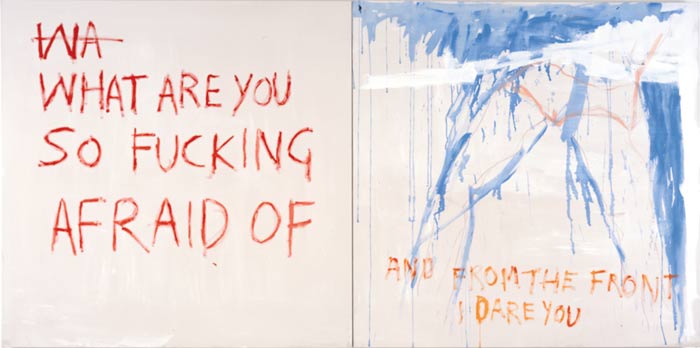
Tracey Emin,WHAT ARE YOU AFRAID OF, 2001.
Philosophy's response to the new world of terrorism.
In the work of Derrida a deconstructive philosophy pays close attention to language to expose the rhetorical strategies at work within the politics of a war on terror; exposes the way the uncritical use of words like ‘terrorism’ and 'war' in the political discourse that now dominates public space and the media; and pays close attention to the contradictions, tensions and conflicts that make mutual understanding and dialogue difficult in practice.
October 21, 2004
female sensibility

Julia Rrapp, Coogee Paul, 2003 from Fleshstones
Her background as an artist is an active involvement in the critique of what dictates the approach to female sensibility by challenging the negative ideas and attitudes that suggest that women are inferior.Primarily a photographer, Rrap’s early work of mixed media, then moved to installations and large series of self-portrait images in religious or historically significant poses.
October 20, 2004
Derrida: In Memoriam
The conservative response. This sees Derrida as the mad axeman of Western philosophy, who tried to hack apart the very basis of our thought - language, reason and the attempt to tell big stories about how we became as we are. So all we are left with - if we accept Derrida's conclusions - is puzzled silence and irony.
I see Derrida quiet differently --as one critically working within the philosophical tradition. So I see him more in terms of the text below, which is courtesy of Dialogic.
"On Jacques Derrida" by Judith Butler
October 9, 2004
How do you finally respond to your life and your name?" Derrida raised this question in his final interview with Le Monde, published in August 18th of this year. If he could apprehend his life, he remarks, he would also be obliged to apprehend his death as singular and absolute, without resurrection and without redemption. At this revealing moment, it is interesting that Derrida the philosopher should find in Socrates his proper precursor, that he should turn to Socrates to understand that, at the age of 74, he still did not quite know how best to live. One cannot, he remarks, come to terms with oneâs life without trying to apprehend oneâs death, asking, in effect, how a human lives and dies. Much of Derridaâs later work is dedicated to mourning, though he offers his acts of public mourning as a posthumous gift, for instance, in The Work of Mourning published in 2001. There he tries to come to terms with the death of other writers and thinkers through reckoning his debt to their words, indeed, their texts; his own writing constitutes an act of mourning, one that he is perhaps, avant la lettre, recommending to us a way to begin to mourn this thinker who not only taught us how to read, but gave the act of reading a new significance and a new promise. In that book, he openly mourns Roland Barthes who died in 1980, Paul de Man, who died in 1983, Michel Foucault, who died in 1984, and a host of others, including Edmund Jabes (1991), Louis Marin (1992), Sarah Kofman (1994), Emmanuel Levinas (1995) and Jean-Francois Lyotard (1998). The last of the essays, for Lyotard, included in this book is written six years before Derrida's own death. It is not, however, Derridaâs own death that preoccupies him here, but rather his "debts." These are authors that he could not do without, ones with whom and through whom he thinks. He writes only because he reads, and he reads only because there are these authors to read time and again. He "owes" them something or, perhaps, everything, if only because he could not write without them; their writing exists as the precondition of his own; their writing constitutes the means through which his own writing voice is animated and secured, a voice that emerges, importantly, as an address.
It strikes me as strange that in October of 1993 when I shared a stage with Derrida at New York University, I had a brief, private conversation with him that touched upon these issues. As we were seated at a table together with some other speakers, I could see in Derrida a certain urgency to acknowledge those many people who had translated him, those who had read him, those who had defended him in public debate, and those who has made good use of his thinking and his words. I leaned over after one of his several gestures of nearly inhuman generosity and asked him whether he felt that he had many debts to pay. I was hoping, vainly it seemed, to suggest to him that he need not feel so indebted, thinking as I did in a perhaps naively Nietzschean way that the debt was a form of enslavement, and that he did not see that what others offered him, they offered freely. He seemed not to be able to hear me in English. And so when I said "your debts," he said, "my death?" "No," I reiterated, "your debts!" and he said, "my death!?" At this point I could see that there was a nexus between the two, one that my efforts at clear pronunciation could not quite pierce, but it was not until I read his later work that I came to understand how important that nexus really was. He writes, "There come moments when, as mourning demands (deuil oblige), one feels obligated to declare one's debts. We feel it our duty to say what we owe to the friend." He cautions against "saying" the debt and imagining that one might then be done with the debt that way. He acknowledges instead the "incalculable debt" that one that he does not want to pay: "I am conscious of this and want it thus." He ends his essay on Lyotard with a direct address: "there it is, Jean Francois, this is what, I tell myself, I today would have wanted to try and tell you." There is in that attempt, that essai, a longing that cannot reach the one to whom it is addressed, but does not for that reason forfeit itself as longing. The act of mourning thus becomes a continued way of "speaking to" the other who is gone, even though the other is gone, in spite of the fact that the other is gone, precisely because that other is gone. We now must say "Jacques" to name the one we have now lost, and in that sense "Jacques Derrida" becomes the name of our loss. And yet we must continue to say his name, not only to mark his passing, but precisely as the one whom we continue to address, in what we write, because it is, for many of us, impossible to write without relying on him, without thinking with and through him. "Jacques Derrida," then, as the name for the future of what we write.
* * *
It is surely uncontroversial to say that Jacques Derrida was one of the greatest philosophers of the 20th century, that his international reputation far exceeds any French intellectual of his generation. More than that, his work fundamentally changed the way in which we think about language, philosophy, aesthetics, painting, literature, communication, ethics and politics. His early work criticized the structuralist presumption that language could be described as a static set of rules, and he showed how those rules admitted of contingency and were dependent on a temporality that could undermine their efficacy. He wrote against philosophical positions that uncritically subscribed to "totality" or "systematicity" as values, without first considering the alternatives that were ruled out by that preemptive valorization. He insisted that the act of reading extends from literary texts to films, to works of art, to popular culture, to political scenarios, and to philosophy itself. The practice of "reading" insists that our ability to understand relies on our capacity to interpret signs. It also presupposes that signs come to signify in ways that no particular author or speaker can constrain in advance through intention. This does not mean that our language always confounds our intentions, but only that our intentions do not fully govern everything we end up meaning by what we say and write (see Limited Inc., 1977). Derridaas work moved from a criticism of philosophical presumptions in groundbreaking books such as On Grammatology (1967), Writing and Difference (1967), Dissemination (1972), The Post Card (1980), and Spurs (1978), to the question of how to theorize the problem of "difference." This term he wrote as "differance," not only to mark the way that signification works, with one term referring to another, always relying on a deferral of meaning between signifier and signified, but also to characterize an
ethical relation, the relation of sexual difference, and the relation to the Other. If some readers thought that Derrida was a linguistic constructivist, they missed the fact that the name we have for something, for ourselves, for an other, is precisely what fails to capture the referent (as opposed to making or constructing that referent). He clearly drew critically on the work of Emmanuel Levinas in order to insist upon the "Other" as one to whom an incalculable responsibility is owed, one who could never fully be "captured" through social categories or designative names, one to whom a certain response is owed. This framework became the basis of his strenuous critique of apartheid in South Africa, his vigilant opposition to totalitarian regimes and forms of intellectual censorship, his theorization of the nation-state beyond the hold of territoriality, his opposition to European racism, and his critical relation to the discourse of "terror" as it worked to fortify governmental powers that undermine basic human rights, in his defense of animal rights, in his opposition to the death penalty, and even in his queries about "being" Jewish and what it means to offer hospitality to those of differing origins and language. One can see these various questions raised in The Ear of the Other (1982), The Other Europe, Positions (1972), For Nelson Mandela (1986), Given Time (1991) The Gift of Death (1992), The Other Heading: Reflections on Today's Europe (1992), Spectres of Marx (1993), Politics of Friendship (1994), The Monolingualism of the
Other (1996), Philosophy in a Time of Terror (with Jurgen Habermas) (2002), and his conversations with Helene Cixous, Portrait of Jacques Derrida as a Young Jewish Saint (2001).
Derrida made clear in his small book on Walter Benjamin, The Force of Law (1994), that justice was a concept that was yet to come. This does not mean that we cannot expect instances of justice in this life, and it does not mean that justice will arrive for us only in another life. He was clear that there was no other life. It means only that, as an ideal, it is that toward which we strive, without end. Not to strive for justice because it cannot be fully realized would be as mistaken as believing that one has already arrived at justice and that the only task is to arm oneself adequately to fortify its regime. The first is a form of nihilism (which he opposed) and the second is dogmatism (which he opposed). Derrida kept us alive to the practice of criticism, understanding that social and political transformation was an incessant project, one that could not be relinquished, one that was coextensive with the becoming of life itself, and with a reading of the rules through which a polity constitutes itself through exclusion or effacement. How is justice done? What justice do we owe others? And what does it mean to act in the name of justice? These were questions that had to be asked regardless of the consequences, and this meant that they were often questions asked when established authorities wished that they were not.
If his critics worried that, with Derrida, there are no foundations upon which one could rely, they doubtless were mistaken in that view. Derrida relies perhaps most assiduously on Socrates, on a mode of philosophical inquiry that took the question as the most honest and arduous form for thought. "How do you finally respond to your life and to your name?" This question is posed by him to himself, and yet he is, in this interview, a "tu" for himself, as if he is a proximate friend, but not quite a "moi." He has taken himself as the other, modeling a form of reflexivity, asking whether an account can be given of this life, and of this death. Is there justice to be done to a life? That he asks the question is exemplary, perhaps even foundational, since it keeps the final meaning of that life and that name open. It prescribes a ceaseless task of honoring what cannot be possessed through knowledge, that in a life that exceeds our grasp. Indeed, now that Derrida, the person, has died, his writing makes a demand upon us, bequeathing his name to us who will continue to address him. We must address him as he addressed himself, asking what it means to know and approach another, to apprehend a life and a death, to give an account of its meaning, to acknowledge its binding ties with others, and to do that justly. In this way, Derrida has always been offering us a way to interrogate the very meaning of our lives, singly and plurally, returning to the question as the beginning of philosophy, but surely also, in his own way, and with several unpayable debts, beginning philosophy anew.
October 19, 2004
Stephen David Ross Interview: The Gift as Art #11
This post picks up on this post that commented on this part of Rick Visser's interview with Stephen David Ross over at Artrift called the Gift as Art.
If progress, profit and utility are the ethos of the market, then there is an ethical and aesthetic value to the ritual significance of exchange as gift. This aesthetic can be seen as destabilizing the market ethos that has triumphed in the Australia of the 21st century.The aesthetic expresses an alternative form of civilization that welds together an inclination towards non calculating enjoyment, an ethics of expenditure of material goods and sensations that stands in opposition to the useful.
In the 11th part of the interview Stephen David Ross says:
"We may read Nietzsche as opening the possibility, foreclosed from the beginning in the quarrel between art and philosophy, that art is the highest way. Or we may read him to open the possibility, present for us from the beginning, that the diaphora is not an opposition, undermining the idea of the highest way. Poetry, art, do not order being from high to low, do not order representation or experience, but cherish every nuance, every detail, every loss and every gain, perhaps as a mother cherishes every gesture of her child, perhaps in a more masculine way. Perhaps. Art and poetry show us, perhaps, that cherishment is possible for those who are not mothers, that maternal care extends beyond the child and mother, that nature everywhere, and humanity everywhere, may cherish and may be cherished, together with loss, with sacrifice, aware as Hegel may not be of its contamination (pp.163-164).”
I had not read Nietzsche that way.
I had read him as highlighting the difference between art and science and as suggesting we look at the world through the eyes of art, and not those of a positivist science. Art was also the countermovement to nihilism and the ascetic ideal and it preserves the political and ethical thrust of a radical critique of values, thanks to the transvaluation of values.
Nietzsche's aestheticism highlights the Dionysian affirmation of life against a Socratic rationality" that is against our bodily instincts and a Christian religion (a reactive religion of ressentiment and bad conscience) that is hostile to life.
The Dionysian affirmation of life counterbalances the interpretation of the will to power as a Hobbesian-like play of forces that bring about domination and mastery (over nature, persons, and things) with one that recognizes and affirms forms of otherness through an aesthetic model of subjectivity of giving style to one's character.
Stephen's conception 'cherish' is a long way from Nietzsche's Stoic harshess and tragic view of life. Nietzsche's mater morality would oppose cherish as a virtue as being part of a slave morality.
October 18, 2004
music: another history
 Bob Dylan's memoir, Chronicles, Vol. 1 is being picked up and favourably assessed.
Bob Dylan's memoir, Chronicles, Vol. 1 is being picked up and favourably assessed.
See here and here and here for Australian weblogs.
Dylan's Chronicles appear to highlight his roots in folk, blues and country music as well as outline the way he tried to deconstruct his 1960s superstar image.
Dylan's memoir chronicles a history of the relationship between folk and rock music, and so works within a particular understanding of the movement of popular music.
There is another kind of history. This is one that is structured around the transgressions of the modernist music project of the 20th century: especially the sixties' phenomenon of minimalism, which can be seen as the apogee of modernism. Minimalism succeeded in deconstructing western music to its basic signifiers--- a beat, a chord, a sound---as can be found in the spartan textures of Anton Weber. The musical purity appealed of a John Cage appealed, but it was generally seen as too academic, too bounded by the musical institution as art, and too divorced from my lived experience.
What was more attractive was musique concrete, which was based on the use and manipulation of real (concrete) sounds. These sounds, as in the work of Stockhausen, were sampled or recorded as part of the creative and composition process. I saw Stockhausen as progressive compared to the conservative "abstract" classical music, which was traditionally composed by writing down the score and later performed by musicians.
The influence of musique concrete can be seen in rock music, (The Beatles, Pink Floyd, The Grateful Dead & Frank Zappa) and in jazz musicians such as Miles Davis. It helped to transgress the old musical boundaries between jazz, rock and the modernist art music and create linkages between the academy and popular music. This legacy is carried on by John Oswald's connections between the pioneer spirit of the 60s with the 90s' postmodern referentiality. His plunderphonics piece Grayfolded (1995), built around The Grateful Dead's Dark Star, links back to the experimentation of the Dead's early Anthem Of The Sun.
Fluxus as an avant garde movement was also important in breaking down the boundaries. The movement impacted on rock music through Yoko Ono's impact on John Lennon in The Beatles and then the Plastic Ono Band.
The significance of this history is the breakdown of hierarchical barriers around music during the 1970s and 80s between Western art music, African-American music, and the genres of rock, folk and jazz. This has resulted in a tendency to embrace music outside of a given genre in order to forge new sounds within specific contexts.
October 17, 2004
Pierre Klossowski
 This image is by Pierre Klossowski (1905-2001). It is from his book entitled The Revocation of the Edict of Nantes.
This image is by Pierre Klossowski (1905-2001). It is from his book entitled The Revocation of the Edict of Nantes.
Klossowski played a significant role in French art, literature, and philosophy from the 1930s through the 1980s. He has a substantial corpus of erotic novels and drawings. His writings rehabilitate the Marquis de Sade as a figure of legitimate literary significance and explore the philosophical dimensions of pornography.
I can see that Klossowski was interested in the philosophical implications of Sadean pornography, rather than in violence, excess, and immorality as tools of socio-political contestation. The novels were later collected under the title The Laws of Hospitality).
The Revocation of the Edict of Nantes primarily recounts the adventures of Octave, an aging Catholic scholar who willingly gives his wife (Roberte) to all willing guests in their home so that he may experience voyeuristic pleasure and provide his nephew Antoine with a sexual education.
As with Sade, it is at first glance difficult to discern any philosophical or theological message at work in such an apparently one-dimensional narrative, particularly in light of the accompanying pencil drawings of explicit sex scenes (often orgies laced with sado-masochism) and solitary nude women displayed in various pornographic poses. It is a blueprint for male fantasy (the neurotic imagining himself as a pervert) in which the figure of the wife (Roberte) is a reproduction of Octave's obsessive image (phantasm) of his wife's body; a obsessive image expressed by the drawings.
However, I understand that Klossowski's work drew attention from influential critics such as Maurice Blanchot, Gilles Deleuze, Jean-François Lyotard, and Jean Baudrillard. And I can see that there is a movement away from the humanist view of experience, in which each individual comforts him or herself with the absolute, irreducible uniqueness or originality of their feelings (however pained) – 'no one else feels as I do at this moment'.
The conservative view sees all people as figures within a pre-structured game or book of life, the 'same old song', as has it. The question of living then becomes a process of recognising – or surrendering – to this pre-givenness and fundamental non-uniqueness of individual experience, to this 'eternal return' which shapes us.
This is given a twist by Nietzsche and Klossowski we do not experience this flow of bodily desires as precious individuals that we would; rather, we do so as conglomerations of moments, echoes, gestures, postures, behaviours. These movements, these intensities, are repeated, and so in some way the same person is there, suggested with the movement of a hand, for example". This view of life is seen as a freeing from the tormenting prison of the individualist ego.
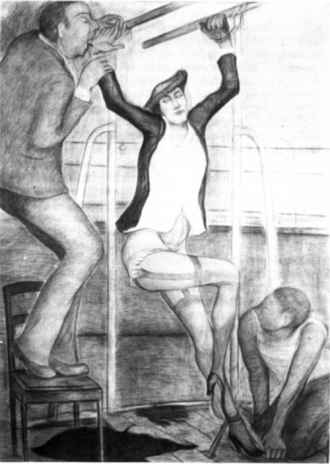 In his novel Roberte ce soir (1954).Octave, institutes an eccentric law in his household: the 'rule of hospitality' invites any guest to take advantage of his wife, Roberte. Their nephew Antoine looks on, bemused by but attracted to this odd arrangement, and to the scurrilous dialogues and couplings to which it gives rise.
In his novel Roberte ce soir (1954).Octave, institutes an eccentric law in his household: the 'rule of hospitality' invites any guest to take advantage of his wife, Roberte. Their nephew Antoine looks on, bemused by but attracted to this odd arrangement, and to the scurrilous dialogues and couplings to which it gives rise.
My judgement is that Klossowski reproduces the phallocentric gaze and power dynamic of “generic” pornography by staging the male fantasy of violent sexual domination. Within this fantasy the women, as object of male desire, is continuously tempted, inevitabily won, not so much by the impulses coming from the outside as by her own bursting, irresistible carnal desires.
A useful counter-example is the recent push by several female French filmmakers to produce sexually explicit work that subverts the power of the male gaze and addresses women’s fantasies and desires. One approaches is represented by Catherine Breillat’s Romance (1999), which uses graphic intercourse scenes as a basis for questioning the complicated relationship between physical and emotional intimacy.
October 16, 2004
a light moment, mostly music
I'm very tired. I just want to rest after experiencing the surgeon's knife on my feet. The pain and drugs are knocking me around a bit, leaving me spacey and immobile. I'm a bit disappointed because I wanted to hang about the galleries this afternoon.
Another kind of show.
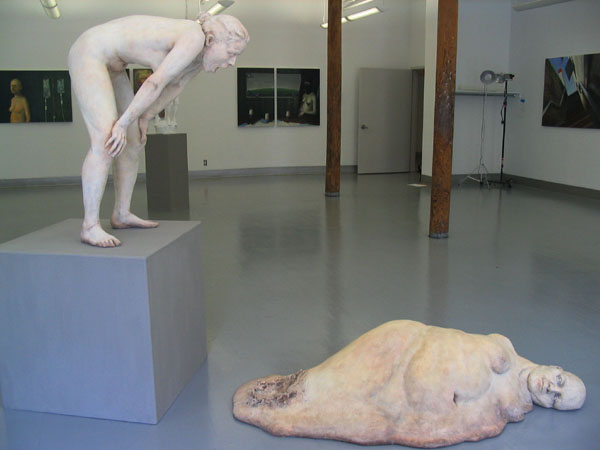
Matti French
via the always excellent Dr. Meno.
So I'm at home listening to Squeezing out Sparks (1979) by Graham Parker and the Rumor. I'm revisiting the 70s from the perspective of pub/punk music rather than the 60s.
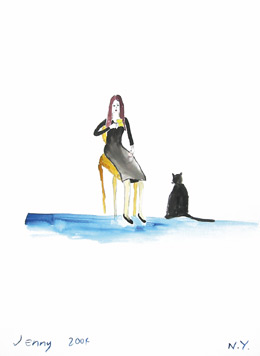
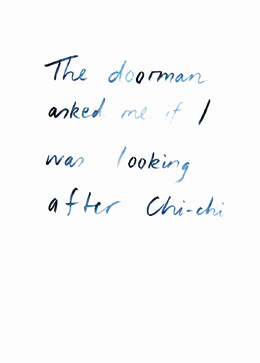 Jenny Watson, "self titled" 2004, watercolour on paper, diptych.
Jenny Watson, "self titled" 2004, watercolour on paper, diptych.
I reckon that Parker produced one of the best pieces of music to come out of the late seventies pub/punk boom. It got me thinking about us still needing song and dance storytellers (such as Bob Dylan) to fill the void in meaning we all share from living in a market culture; story tellers that need not be rogue radicals or princes of protest.
But I go back to listening to the spacey exploratory sounds of Grayfolded. This was created by John Oswald. He took around a 100 live performances of the Grateful Dead's freeflowing Dark Star jam between 1968 and 1993, and then built, layered and folded them to produce a new, recomposed piece of music. This is the good side of postmodernism in music.
John Oswald calls the technique plunderphonics. Another example--the Grey Album.
An interviewwith John Oswald. An article on recontextualising the musical data that surrounds us, then juxtaposing fragments to create new meanings from old.
pop surrealism

Shag, Surf Monsters
via the excellent Dr. Meno
That is surrealism now. This is then. As is this:

Frida Kahlo, What the Water Gave Me, 1938, Oil on canvas
October 15, 2004
desire
It is the chaotic impulses of desire that moves our bodily selves, as Bettina Rheims and Balthus well knew.
An interview with Larry Clark primarily about the film Kids.
Clark's film Ken Park has been banned in Australia. A DVD is circulating within the teenage culture.
Desire and censorship. They go together in our culture like salt and pepper in cuisine.
October 14, 2004
dead public spaces
There are so many of these kind of windswept, lifeless public spaces in our cities, which have been created by corporate modernist architecture.
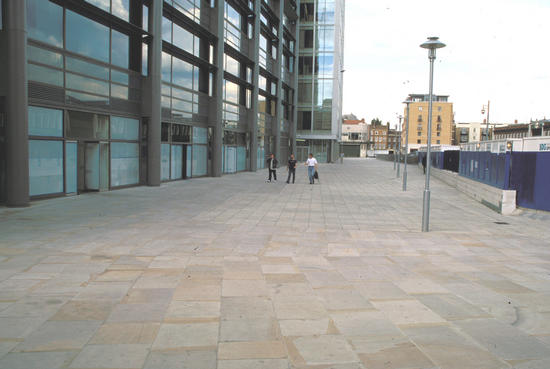
ABN Amro Headquarters
Our cities are full of them. The people over Projects for Public Spaces say about modernist buildings such as these:
"The design of these buildings, like the Canary Wharf complex, is driven by fear. They are designed to be separate and apart, aloof and indifferent to the world that they have removed themselves from. It is scary to think what the people are like inside these building, what decisions they make and what impact they have on the rest of the world."
They add that we should build on what is there, rather than destroying centuries of growth and imposing something so superficial and empty in its place.
October 13, 2004
lively public spaces
Piazza el Campo, Siena, Tuscany This post is courtesy of The Adelaide Review. It comes from this article by Chris Bowe.
This post is courtesy of The Adelaide Review. It comes from this article by Chris Bowe.
This is about this article by the Project for Public Spaces in their Making Places newletter.
The article is called, 'Six parks we can all learn from', and it asks: 'Why do some parks succeed as lively public spaces while others fail?'
One public square that succeeds is the Piazza el Campo in Siena, Tuscany:
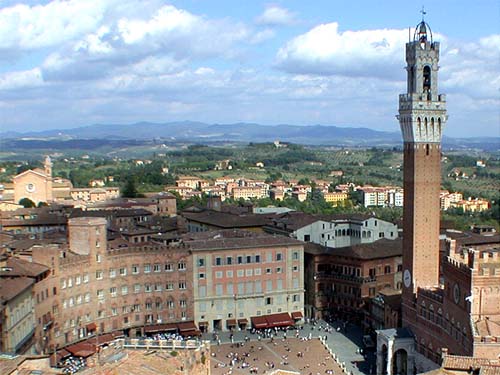
It bears the title of the world's best square/plaza.
So why do some public spaces fail?
Some of Adelaide's public squares/parks fail to meet the needs and desires of people who would use them. Though Victoria Square occupies a major place in the heart of Adeliade's urban community, it adds very little to the identity or quality of our city. As Chris observes
"Adelaide’s Victoria Square is absent from the winner’s circle and is too far gone to make the “Worst” list – a category with a qualifying clause that salvation is both desired and possible."
Why?
Kathy Madden in the Making Places newsletter outlines some characteristics that make a public space bad. She says:
"For a park to attract visitors, people must be able to get inside easily. But a surprising number of parks are incredibly difficult to reach, whether because of high-volume traffic on surrounding streets or poorly conceived entrances.Once inside a park, you need things to hold your interest. Many parks that could be spectacular public places offer virtually nothing to do -- and as a consequence they're thin, without the variety of activity common to the best parks.
Parks are frequently located next to major cultural institutions like museums, schools, and concert halls. Too often, however, these neighboring institutions have little or no presence in the park itself. To succeed as centers of civic life, parks must capitalize on the impact of nearby institutions, engaging them as partners."
All these apply to Victoria Square. thanks to the engineers the diagonal square is seperated fromthe important buildings on all sides by north south car flows; whilst the square is dissected in the middle by east west car flows.
That is why it is a disaster zone as a liveable public space compared to Piazza el Campo in Siena, Tuscany:

The first step would be to ban the cars from Victoria Square---but the Adelaide City Council and State Government are deeply opposed to such a course of action. A car invaded city is good for business in their eyes.
The best bet would be to turn Victoria Square into a giant car park.
October 12, 2004
Monasteries & Modernism
I've always been critical of minimalism as a mode of dwelling. But sometimes the stark simplicity that rejects the ninteenth century cottage loved by the heritage industry makes sense.

John Pawson, The Church at Novy Dvur, 2002
Consider the Cistercian Order, a cloistered community whose mode of life is based on simplicity, utility, economy. These principles, which lie at the heart of the Cistercian aesthetic, resonate with the modernist desire to eliminate what is ostentatious and superfluous, to choose the simplest solutions and materials whilst making no concessions on the quality of the workmanship and to harness the dramatic qualities of natural light.
The artwork emphasizes the profound links between Minimalism and spirituality.
John Pawson'sspeech
October 11, 2004
teenage culture
This image is at odds with traditional families.

Bruce Davidson, 1959, From the Brooklyn Gang Series
This is from a series of photos of youths living in Brooklyn during the 50's. If this is the 1950s then what period do the moral conservatives (Family First) have in mind when they refer to traditional families?
So what happens to the street kids living in our cities in the new moral world of traditional families, no sex before marriage and no drugs?

Bill Henson, Untitled #20, 1998
Does charity pick up the pieces?
October 10, 2004
politics
The results of the federal election have depressed me. The hegemony of social conservatism is going to continue for quite some time.

It is all about families. Traditional families. Christian families. Heterosexual families. Families standing on suburban lawns behind those famous white picket fences.
What about lefty non-Christian (secular) singles or couples? What happens to those living in the inner city in apartments?
They become exiles on main street says Chris Shiel over at Back Pages.
That takes us back to the 1970s, to rock'n roll, Cocksucker Blues and heavy drug use. The documentary by Robert Frank refers to anarchy, drug dealers, freaks and crazy people left over from the Sixties, all defiant and distorted; freaks hanging out in dark and hidden places on Route 66; the disenfranchised lonely people barely getting by, disconnected, and insecure; and the despair and loneliness of life on the road.
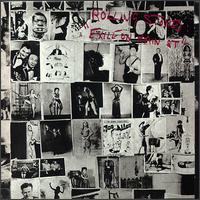 The photo by Robert Frank for Exiles on Main Street is linked to the freaks looking for the American dream and the the film of the band on tour.
The photo by Robert Frank for Exiles on Main Street is linked to the freaks looking for the American dream and the the film of the band on tour.
On Route 66 a sadness can be found in the forlorn looks of dime store waitresses, funeral attendees, and human faces rendered unrecognizable in the glare of jukeboxes in a landscape of people and places absent of hope and promise.
And not only on Route 66 as mapped by Robert Frank in The Americans in the 1950s. A more contemporary image.

Bruce Davidson, from the series Central Park
In contrast, the images of traditional families are everywhere these days and they are associated with a pro-family agenda. That agenda says that too many taboos were lifted in the 1960s. They need to be firmly reimposed.
What taboos needs to be firmly imposed by this moral politics? Try this image over at Creativity Machine.
Here is my stab. The taboos refer to the reimposition of anti-censorship laws. It is held that violence and "obscene material" in videos and the internet leads to child pornography. 'They' also addresses the breakdown in community values (caring, sharing and kindness) by including religious values in the political debate.
The big taboos are the sexual ones. The family is about marriage not sex with whoever you want when you. It means sexual abstinence (as a form of birth control and prevention of sexual diseases); no to condoms; and no to abortion if the families teenage daughter gets pregnant.
Another taboo is no drugs. Another is no to homosexuality and gay marriage. It is not family friendly you see.
What the taboos presuppose is a conservative nation: a society in which economic individualism thrives, we can make tons of money in the private sector plus the hegemony of old-fashioned social values and maintaining the nation's traditional heritage. A conservative nation is one in which religious values say it is good to make lots of money.
Of course, making a lot of money in a free market implies a consumer society with a visual culture of sexual advertising to move the product. That market culture undermines the conservative anti-sex values and Judaic Christian traditions.
October 07, 2004
architecture and history
Here is some background to the extension of the Berlin Museum and its Jewish wing mentioned in this this text:
"According to planners, the Jewish wing would be both autonomous and integrative, the difficulty being to link a museum of civic history with the altogether uncivil treatment of that city's Jews. The questions such a museum raises are as daunting as they are potentially paralyzing: How to do this in a form that would not suggest reconciliation and continuity? How to reunite Berlin and its Jewish part without suggesting a seamless rapprochement? How to show Jewish history and culture as part of German history without subsuming it altogether? How to show Jewish culture as part of and separate from German culture without recirculating all the old canards of "a people apart"?"
The text goes on to say that rather than skirting these questions, the planners confronted them unflinchingly in conceptual brief for the competition that put such questions at the heart of the design process.:
"According to the text by Rolf Bothe (then director of the Berlin Museum) and Vera Bendt (then director of the Jewish Museum Department of the Berlin Museum), a Jewish museum in Berlin would have to comprise three primary areas of consideration: (1) the Jewish religion, customs, and ritual objects; (2) the history of the Jewish community in Germany, its rise and terrible destruction at the hands of the Nazis; and (3) the lives and works of Jews who left their mark on the face and the history of Berlin over the centuries.16 But in elaborating these areas, the authors of the conceptual brief also challenged potential designers to acknowledge the terrible void that made this museum necessary. If part of the aim here had been the reinscription of Jewish memory and the memory of the Jews' murder into Berlin's otherwise indifferent civic culture, then another part would be to reveal the absence in postwar German culture demanding this reinscription."
October 06, 2004
Stephen David Interview:#10-C
I want to return to here and pick on this.
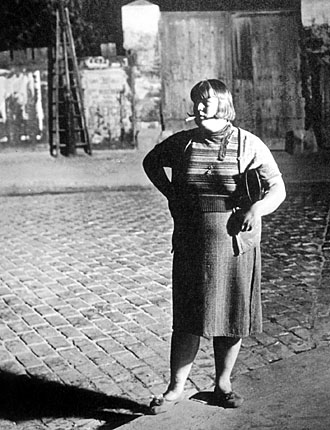
Brassai
In part 10 of his interview conducted by Rick with Stephen David Ross over at Artrift, Stephen says:
"We look at art, we go into a gallery, we attend to works by artists, in order to understand, to focus, to pay attention to meanings. In short, to understand the meanings of things, sometimes of ordinary experiences, differently perhaps. I like the perhaps and I like the differently. But the meanings and understandings that come with artistic spaces, artistic works, they seem to me to be what images are all about. That is, there are images, too many images, and they do not hold still. They move and proliferate. The meanings they embody and reveal move and proliferate as well. We lose sight, we are overwhelmed, distracted, have other things to worry about. Art presents the image for us so that we can dwell upon it, pay attention to it, let ourselves be moved by it, thereby to understand, experience, feel, reflect. All this without insisting on fixing and on grasping the image. Art is a particular, poignant, intense reflection on the multiplicity and multiplication of images, on the overabundant expressiveness of things."
Well we do live in a world of images that move and proliferate. And art galleries are a world full of diverse and ever changing images.
And is presenting an image and a reflection on the multiplicity of images.
Well not just a reflection of other images. They are a reflection on the way images embody a form of life.
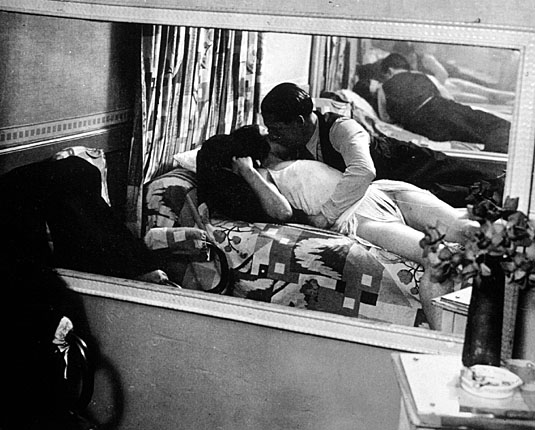
Brassai
Instead of embody I would use mimesis, which discloses a basic affinity between things and persons that is not based on rational knowledge. It is based on experiences of the nonidentical.
In the case of Brassai's postitutes it would be experience beyond the exchange of money for sex. Say the experience of intimacy in a world of silences.
October 05, 2004
prostitution
A well known photograph

Brassaï, Paris Prostitute, 1933
Here is one painting:

Balthus, La Chambre Turque, 1963-66
And another:

Bettina Rheims, Chambre Close, 29 Octobre III, Paris 1991
Both are paintings of prostitutes in France from the perspective of a male client.
We would say sex workers now---strippers, phone operators, prostitutes, porn actresses etc. of all genders and persuasions. There is far greater symapthy for the repeal of the prostitution laws prohibiting the soliciting or engaging in an act of prostitution, far greater concern for health and safety issues of sex workers and a desire an end to the stigma and taboos associated with sexual work.
A text. And another. Economists thinking about prostitution.
October 04, 2004
architecture: mimesis & critique
Over at philosophical conversations there has been a few posts on Heidegger and his ideas of dwelling and building.
How about mimesis? Can it be applied to architecture? If mimesis is seen as a faithful copying or imitation of a given reality, then no. Architecture is not like a documentary photograph.
But if mimesis is seen in terms of affinities and correspondences, then there is no longer any reason for disconnecting architecture from minesis. A house, for isntance, represents a basic experience that is structured on the inside/outside distinction. The house draws a line between what is private and what is public. A building discloses a world.

Daniel Libeskind, Jewish Museum Berlin, 1999
What of critique? Can we talk of a critical architecture? Can it be oppositional? Say dealing with reality in another way than the commercial one of our urban developers?
Can architecture by making use of mimesis ---consciously or unconsciously---develop strategies by which it can represent itself as critical architecture? I mean something more than highbrow architecture as art. I mean something along the lines of the way that it deals with social reality.
How about this? Building a Jewish Museum in what was the capital of the Third Reich. Is that not fraught with historical reverberation and emotional ambivalence?
 the basic form is is a zizag with a number of voids. These voids ae 5 stories high. As visitors follow the zig zag pattern through the museum as dictated by the layout of the building they are repeatedly confronted by these voids.
the basic form is is a zizag with a number of voids. These voids ae 5 stories high. As visitors follow the zig zag pattern through the museum as dictated by the layout of the building they are repeatedly confronted by these voids.
The voids are accessible nowhere and appear to be meaningless or senseless. They are just cold gloomy depths. The flowing movement breaks down.
Visitors have to enter the zig zag of the Jewish Museum through the old Berlin museum, which provides a link to new complex through the basment.
The Jewish Museum itself, from the outside, is an enigmatic and impenetrable volume.
Does this not begin to give an account of the fatal mutual involvement of German and Jewish culture in terms of a critical mimesis? One based on a number of voids within a zig zag?

A silence, an absence of words within the tortorous line of history.
October 03, 2004
Madonna/Whore
I'm not impressed by, or much taken with her music, but Madonna has created, and performed, a new paradigm of womanhood: power wrapped in sexuality.
She has portrayed herself as the high-priced prostitute, the dominatrix, the stripper toying with the impotent voyeur, the unwed mother, the naked slave girl. In doing so she has pushed the power of female sexuality to the forefront of the public eye.
Good on her. What went before was pretty feeble.

The Bettina Rheims Sessions 1994
This session has stylistic links to Rheims Bettina's 191-2 Chambre Close project
Madonna is a French prostitute in a seedy hotel in 1930s Paris.

The Bettina Rheims Sessions 1994
The madonna-whore complex. Rather neat. A woman is either put on a pedestal, protected, taken care of, treated as a goddess or the mother of my children; or she is used for sex, emotionally and perhaps physically abused, and seen as nothing more than "a slut." In a patriarchal culture , women must fall into one of these two categories.
The clandestine prostitution subculture of the 20th century is more into the limelight prostitution is coming out into the open. Do we accept prostitution as a purely economic exchange, inherently no more or less degrading for either buyer or seller than any other professional relationship? Can we same the same arguments against prostitution—buying or selling—can be made against any professional service: psychologist, psychiatrist, doctor, lawyer, priest, minister?
Athletes, actors, actresses, and construction workers "sell" their body. The body is what is needed to engage in physical work. It would be difficult to engage in any profession without the use and therefore "sale" of one's body.
October 02, 2004
from porn to child porn
Porn has been a contentious issue in the arts and in popular culture for decades. What now comes through the mass media is child porn not porn per se.
Pornography is one of the financial successes of the Internet - and it has been in large part responsible for its enormous rate of growth over recent years. Porn is increasingly being accepted, both as an industry and within high fashion. It is becoming mainstream.
Child porn is another matter entirely. It is children being exploited by pedophiles? Clearly so. Child pornography is sickening images of adults having sex with young children. Or more accurately, child pornography is the sexual and physical abuse of the body of children under 16. Hence the police shift away from porn to child porn.
If it is indecently assaulting children, then is child pornography also purchasing images of child abuse. Or is it possessing indecent photos? Does 'indecent' piggy back on the pornographic as sexual and physical abuse? I suspect that it does in a lot of commentary.
So what is 'indecent'? Is 'indecent' sexual photos of young girls designed for the pleasure of men or women?
Is that pornography? Is it an indecent image?
Is a photo of a child taken by her mother indecent?:

Sally Mann, "Gum", "Shiva at Whistle creek", 1992
Is the Mann image indecent? Is it pornographic?
If I downloaded that image onto a computer, is that an act of making an indecent image? Is my reposting the image on the internet an act of distributing an indecent image?
What makes an image indecent? Is it the sexualness?
There is a lot of downloading of sexual imagery going on. So how does the relationship between free speech and child protection on the net actually work ? What comes through the media reports is a 'watch out as we know what you're up to' message.
There does seem to be a slide from the indecently assaulting children to possessing indecent photos in the various media reports. That slide is what is problematic.
What does not come through these kind of headlines is the very complicated debate about bodies, representation, feminism, political correctness, desire, perversion and pleasure that has being going on for a couple of decades. It is a debate that has arisen with the visualization of female eroticism in its sensual, emotional and disquieting expressions.
October 01, 2004
Sean Scully#2

Sean Scully, 11.25.90, 1990
Sean Scully says:
"The pastels, those big pastels that I make, are very monumental. And they have a dryness. The material is pressed into the paper over and over and over again. Behind glass, they’re blurred, they’re indistinct. They have a physicality, but they have the physicality of powder … or chalk, whereas the paintings are shiny, inherently shiny. In other words a pastel doesn’t really have a skin. It’s full of air. You know, a pastel, one doesn’t get the sense with a pastel that it has an outer skin, that it has a beginning and an end. It seems, well, it’s powder, so one is chasing its outer and inner extremities when one’s looking at it, because you don’t really know where it starts and where it ends. But with the skin of oil paint, you do."
That statement is all about the physicality of the paint. Nothing at all about the cultural meaning of the way the paint has been put together as an art work that is acquired and exhibited in a museum.
How naive. Paintings are about signification as well as paint.



